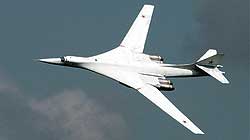 |
Might of the White Swan
Performance
Max. speed: 2,220 km/h, faster than most fighter aircraft
Serving ceiling: 49,200ft, higher than any US bomber
Range: Almost halfway around the world with aerial refueling
Dimensions
Length: 178ft, that’s 56 ft longer than the US Space Shuttle
Height: 43ft or three stories tall
Wing span: Longer than INS Viraat
Weight and payload
Max. takeoff weight: 275 tonnes (5 times the weight of US’ B-52)
Max. combat payload: 40 tonnes |
|
|
|
|
Game Changer
|
|
As the US stations missiles and radars on the Russian border, Moscow says two can play the game, and sends long range bombers and nuclear warships into America’s backyard. So what’s happening at the frontlines of the new Cold War? |
|
By Rakesh K. Simha
|
|
|
Wednesday, September 10. As dawn breaks at a strategic air base in Saratov, 1000 km south of Moscow, Dmitry Kostyunin, deputy commander of the Russian Air Force’s long range bomber division, holds a secret briefing for his elite crews. Minutes later, two Russian Tupolev Tu-160 White Swan supersonic bombers take off on a mission that is known only to a select few apart from Kostyunin and the pilots. It seems like any of the routine flights that the Russians conducted on an almost daily basis for over three decades up to 1991. NATO aircraft shadow the aircraft off Norway and Iceland, but soon realise they can’t keep up. Developed during the last years of the Cold War, these massive aircraft fly effortlessly over the Atlantic, in the process setting a world record by accepting 25 tonnes of fuel during aerial refuelling over the North Sea.
The warning bells start ringing in the Pentagon as these gigantic planes wing it south of the US. Finally, late in the night, after having flown non-stop for over 15 hours, the Russians land at the Libertador air base in Venezuela, where President Hugo Chavez personally welcomes them. “The Yankee hegemony is finished,” he says on national television.
|
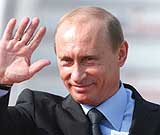 |
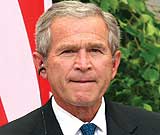 |
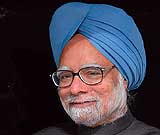 |
Vladimir Putin
Prime Minister, Russia
Putin has nursed Russia back to health and its economy is back in business. Russia holds $500 bn in US treasury bonds —a bigger weapon than any in its arsenal |
George W. Bush
President, US
Bush said Putin is a friend but the neocons, NATO and the military industrial complex need an enemy, and until China is ready, Russia fits the bill perfectly. |
Manmohan Singh
Prime Minister, India
Sure, the US and India are cozying up, and Singh flew to Washington to thank Bush, but India has a strategic relationship with Russia in space and
defence. |
|
|
|
For once, the ‘Yankees’ aren’t calling it yet another rant by the fiercely anti-American Chavez. For, the Tu-160s are strategic game-changers. The White Swan is the most advanced and formidable nuclear bomber in the world. Its variable-geometry, or swing, wings give it a combination of unparalleled range and endurance in the air with the capability of bursts of flight at Mach 2, or 2250 kmph. And it can carry stand-off, nuclear-capable X-555 cruise missiles with a range of 2,000 miles. According to reports, these supersonic missiles can be programmed to target the correct Pentagon window.
The upshot: even a couple of Tu-160 aircraft—with 40,000 kg of munitions on board—could loiter safely 24/7 in international air space and still have the capability to hit multiple targets across the US. Historically, the main US air and missile defense forces face the North Pole, as the main directions of potential nuclear strikes pass over the Arctic Ocean. As a result, the southern direction is much less protected, and the emergence of a potential threat from the Caribbean and the Gulf of Mexico will come as a very unpleasant surprise, considering that the Pentagon's budget is already overstretched.
|
A Lesson for India
What the Russians did in Georgia and Latin America should be a lesson for India’s leaders often caught in a straightjacket when dealing with China and Pakistan. Vladimir Putin and Andrei Medvedev’s strong and united response in the war—during which Russia dismantled Georgia’s US-trained military— should be a lesson in international diplomacy. The Russians did not care for international approval or wait for sympathy and instead went about securing their interests with practised ease.
The availability of the strategic bombers is what gave Moscow the leverage it wanted. The Americans had always insisted on the complete destruction of these very bombers during arms reduction talks, but the Russians held on to the crown jewels of their arms industry.
While acquiring the next generation of weapons platforms, India would do well to realise that game changers can tilt the balance in your favour. Power, ultimately flows from the barrel of a gun. That is why Japan, the world’s second largest economy for over 30 years is a pygmy in global affairs while China, with 300 nuclear weapons, is a country that matters.
|
|
|
Sending the beautiful, gigantic aircraft to Venezuela marks a serious Russian strategic countermove to the unprecedented concentration of US and NATO warships in the Black Sea—regarded by Russia as a private lake for 250 years since the time of the Empress Catherine the Great—and they are also the most aggressive strategic challenge the Kremlin has laid down in the western hemisphere in at least a quarter of a century.
The US, which is deploying an anti-missile system in eastern Europe, now has to deal with the risk posed by its potential enemy's combat aircraft appearing in its own backyard. The arrival of Russian nuclear-powered warships in Latin American waters is another threat multiplier from Moscow.
“These games started in the 19th century when global confrontation was unfolding between the Russian and British empires. Both sides used ships to fly their flags in key regions, signalling their readiness and ability to defend their interests,” says Moscow-based military commentator Ilya Kramnik.
|
|
|
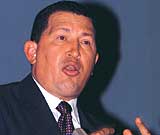 |
 |
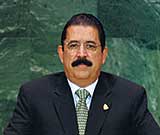 |
Hugo Chavez
President, Venezuela
On September 12, the fiercely anti-American Chavez expelled US ambassador Patrick Duddy. Chavez said the presence of two Russian warplanes on Venezuelan soil for a training exercise is a warning to the rest of the world that Venezuela’s allies include Russia |
Juan Evo Morales
President, Bolivia
On September 11, Morales said on national TV: “Without fear of anyone, without fear of the empire, I declare the ambassador of the United States persona non
grata.” Ambassador Philip Goldberg has been accused of backing a coup against Morales, who is of American Indian origin |
Manuel Zelaya Rosales
President, Honduras
Honduras refused the credentials of a new US ambassador, postponing his appointment. “We are doing this only in solidarity with Morales, who has denounced the meddling of the US in Bolivia’s internal affairs,” Rosales said. However, later Honduras accepted the envoy |
|
|
|
The appearance of Russian bombers in the Caribbean can be interpreted in various ways. Says Kramnik: “Geopolitically, this step is designed to remind Washington of the need to listen to what other countries have to say. After all, if the US is deploying more and more military sites near the Russian borders, it would be strange not to expect an adequate response from Moscow. The landing of Tu-160 bombers capable of carrying considerable nuclear ordnance shows that such a response is possible.” While the US remains supreme militarily and culturally worldwide, recent events signal that it’s dominance is being challenged by new players bent on achieving a multi-polar world. While the Russian foray into Latin America is the most spectacular, a series of events signalling waning American power has been glossed over by the US media.
One, Germany and France have decided not to give the US a carte blanche in NATO. It was their joint decision not to give membership action plans to Ukraine and Georgia. Also, Germany has been a strong supporter of even more reliance on Russian oil and gas pipelines.
Down under, in an unprecedented act, Bolivia expelled its ambassador. Hours later Venezuela did the same in a show of Latin American solidarity. And Honduras refused to accept a new US ambassador to replace the exiting one.
|
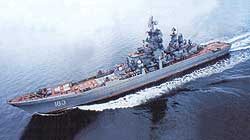 |
RUSSIA’S CARIBBEAN
CRUISE
Powered by two nuclear reactors of 300 MW each, the 750 feet long missile cruiser, Peter the Great, is Russia’s answer to US ships in the Black Sea. It carries 20 nuclear armed cruise missiles and a 727-member crew. Its presence in the Caribbean exposes the US underbelly, posing a new threat to American cities.
|
|
If there was one re-assuring factor during the Cold War, it was that both the US and the Soviet Union kept a safe distance from each other and preferred fighting by proxy. But today the messianic mentality of many American politicians, including presidential nominee John McCain, may prevent a compromise with Russia. They are absolutely convinced they are right, and do not care for the other side's position. This attitude can only aggravate present and future conflicts. At the same time, the Russians will not accept a situation where a European security architecture is being built without it, and mostly against it. Especially since the designs for it are being made by a country that is not even part of Europe.
Meanwhile, the White Swan flights continue over the Atlantic and Arctic. The good natured Kostyunin, who once flew strategic aircraft from the Baltics, says when Russian bomber pilots are intercepted by fighter jets, the feeling is one of camaraderie. “I think the European fighter jets are also happy. The young pilots can see our planes, see how beautiful they are.”
While the mood at the Saratov base is upbeat, on the other side the watchword is caution. At Norway’s Bodoe air base, above the Arctic Circle, a young Norwegian captain tells the media he is one of the fighter pilots who is regularly sent up to face-off with the Russians. “We avoid any provocation,” he insists. “We come from the back and we keep our distance all the time, no less than 500 feet from them. They proceed with their mission normally. They don't do anything special just because we’re there.”
Kostyunin signs off: “The White Swans are a symbol of power but also a symbol of goodwill... The more you know about us, the more you’ll love and respect us.”
|
|
|
|
November 2008
|
|


|
|
|
|